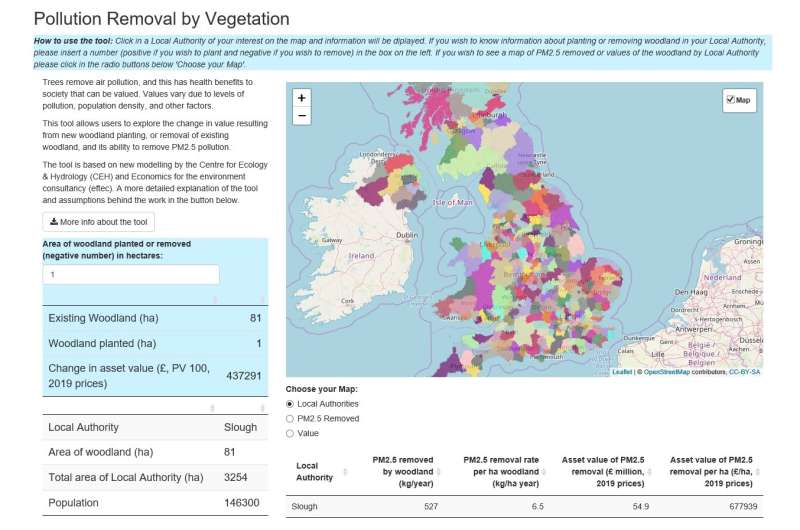Online calculator shows how trees can improve air quality and cut health costs

A new interactive online tool is set to encourage tree planting initiatives across the UK. It calculates how much pollution would be removed by planting trees in local areas, as well as the corresponding public health cost savings.
With hundreds of thousands of trees due to be planted across the country over the next three years in Government-backed schemes, the new tool—Pollution Removal by Vegetation—takes national data and makes it locally relevant and accessible for councils, NGOs, developers and other businesses that are considering such initiatives.
Scientists at the Centre for Ecology & Hydrology (CEH) teamed up with eftec, a leading environmental economics consultancy, to develop the tool, which shows the existing amount of woodland in each local authority in hectares, how much particulate matter (PM2.5) the trees remove from the air and the resulting predicted public health cost saving within that area over a 100-year period.
Based on the number of hectares of woodland someone wishes to plant within a local authority area, it can calculate:
- How many kilogrammes of PM2.5—considered the most serious form of air pollution—would be removed from the air by the extra vegetation
- The resulting public health cost saving within that area over a 100-year period
The tool can also estimate the effects of felling existing woodland by calculating the health costs attributable to the PM2.5 that would no longer be removed from the air by those trees.
The new tool builds on previous research that CEH and eftec carried out for the Office of National Statistics, which estimated that plants in the UK remove 1.4 million tonnes of air pollution and save £1 billion in avoided health costs every year.
Professor Laurence Jones of the Centre for Ecology & Hydrology explains: "There is a lot of public concern about the potential health risks that pollution poses in many urban areas of the UK. While reducing harmful emissions at source is the best way to improve air quality, the addition of vegetation can play a role in removing pollutants within a local area."
Ian Dickie of eftec adds: "Trees make urban areas more attractive and improve local air quality, thereby boosting people's health. As our ongoing research has shown, this in turn can have significant positive economic benefits.
"We regularly hear political commitments to plant more trees in urban areas—our new online tool will inform and support the efforts by local and central government, NGOs, businesses and individuals in adding trees in our towns and cities.
"We were very pleased with the positive feedback we received about the valuation tool from these stakeholders at a recent webinar and hope it will encourage and support their tree planting initiatives in pollution hotspots."
To access the free online tool, visit https://shiny-apps.ceh.ac.uk/pollutionremoval/
You can also download a method note that explains the model and its uses.
The recording of the launch webinar hosted by EKN is now available at https://vimeo.com/341991556 and it takes you through the tool's development and uses.
Provided by Centre for Ecology & Hydrology

















